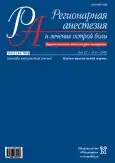The effectiveness of the prevention of the bone cement implantation syndrome during hip arthroplasty
- Authors: Sokolov S.V.1, Zabolotsky D.V.2,3, Koriachkin V.A.2
-
Affiliations:
- Saint-Petersburg hospital for war veterans, Saint Petersburg
- Saint-Petersburg State Pediatric Medical University of the Ministry of Healthcare of the Russian Federation
- The Turner scientific research Institute for children’s orthopedics
- Issue: Vol 12, No 4 (2018)
- Pages: 237-241
- Section: Original articles
- URL: https://journals.rcsi.science/1993-6508/article/view/61295
- DOI: https://doi.org/10.17816/1993-6508-2018-12-4-237-241
- ID: 61295
Cite item
Full Text
Abstract
Objective. Evaluation of the effectiveness of drug prevention of bone cement implantation syndrome in hip joint arthroplasty.
Material and methods. A retrospective analysis of 400 medical records of patients who underwent hip arthroplasty was performed. In the main group (n = 200), the prevention of bone cement implantation syndrome was carried out using popular drugs (mafusol, reamberin, antihistamines, glucocorticoids). In the control group (n = 200), these drugs were not used. Blood pressure, heart rate, blood saturation were evaluated intraoperatively. In the postoperative period, fixed complications associated with anesthesia and surgery.
Results. The volume of intraoperative blood loss, mean arterial pressure, heart rate and blood saturation in the main and control groups did not have significant differences. At the stage of cementing the bone canal, hypotension developed in 95% and 95.5% of cases, respectively. 2 patients (1.0%) of the first group developed a stress-related ulcer bleeding on the 3rd day of the postoperative period, one patient (0.5%) had an Ischemic stroke on the 5th day after the operation, in three patients (1.5%) – atrial fibrillation paroxysm during the week after surgery. Three (1.5%) patients developed a skin allergic reaction to reamberin. In the second group, there were two cases (1.0%) of Ischemic stroke within a week after surgery and one cases (0.5%) of acute myocardial infarction on the 5th day after surgical treatment.
Conclusion. There is no need for intraoperative drug prevention of bone cement implantation syndrome. Additional pharmacological load increases the risk of side effects and complications.
Full Text
##article.viewOnOriginalSite##About the authors
Sergey V. Sokolov
Saint-Petersburg hospital for war veterans, Saint Petersburg
Author for correspondence.
Email: medical-waste@rambler.ru
anesthesiologist
Russian Federation, Saint-PetersburgD. V. Zabolotsky
Saint-Petersburg State Pediatric Medical University of the Ministry of Healthcare of the Russian Federation; The Turner scientific research Institute for children’s orthopedics
Email: medical-waste@rambler.ru
Russian Federation, Saint-Petersburg
V. A. Koriachkin
Saint-Petersburg State Pediatric Medical University of the Ministry of Healthcare of the Russian Federation
Email: medical-waste@rambler.ru
Saint-Petersburg
References
- Shesternya N.A., Gamdi YU., Ivannikov S.V. Perelomy sheyki bedra. M. : BINOM, 2005. (In Russian)
- Smith A.J., Dieppe P., Vernon K., Porter M., Blom A.W. National Joint Registry of England and Wales. Failure rates of stemmed metal-on-metal hip replacements: analysis of data from the National Joint Registry of England and Wales. Lancet. 2012; 379: 1199–204.
- Olsen F., Kotyra M., Houltz E., Ricksten S.-E. Bone cement implantation syndrome in cemented hemiarthroplasty for femoral neck fracture: incidence, risk factors, and effect on outcome. Br. J. Anaesth. 2014; 113: 800–6.
- Donaldson A.J., Thomson H.E., Harper N.J., Kenny N.W.; Bone cement implantation syndrome. Br. J. Anaesth. 2009; 102; (1): 12–22.
- Hossain M., Andrew J.G. Is there a difference in perioperative mortality between cemented and uncemented implants in hip fracture surgery? Injury. 2012; 43 (12), 2161–4.
- Koriachkin V.A., Zabolotskiy D.V., Kuz’min V.V., Anisimov O.G., Yezhevskaya A.A., Zagrekov V.I. Anesteziologicheskoye obespecheniye perelomov proksimal’nogo otdela bedrennoy kosti u pozhilykh i prestarelykh patsiyentov (klinicheskiye rekomendatsii). Regionarnaya anesteziya i lecheniye ostroy boli. 2017; 11 (2): 133–42. (In Russian)
- Griffiths R., White S.M., Moppett I.K., Parker M.J., Chesser T.J.S., Costa M.L. et al. Safety guideline: reducing the risk from cemented hemiarthroplasty for hip fracture 2015. Anaesthesia. 2015; 70: 623–6.
- Koriachkin V.A., Strashnov V.I. Epidural’naya i spinnomozgovaya anesteziya. Sankt-Peterburg: Sankt-Peterburgskoye meditsinskoye izdatel’stvo, 1997. 96 p. (In Russian)
- Singh V, Bhakta P, Zietak E, Hussain A. Bone cement implantation syndrome: a delayed postoperative presentation. J. Clin. Anesth. 2016; 31 (6): 274–7.
- Razuin R., Effat O., Shahidan M.N., Shama D.V., Miswan M.F. Bone cement implantation syndrome. Malays. J. Pathol. 2013; 35 (1): 87–90.
- Kalra A., Sharma A., Palaniswamy C., El-Oshar S., Desai P., Yazbeck M., Zanotti-Cavazzoni S.L. Diagnosis and management of bone cement implantation syndrome: case report and brief review. Am. J. Ther. 2013; 20 (1): 121–5.
- Loskutov A. Ye., Vasil’chenko Ye. V. Oshibki i oslozhneniya pri endoprotezirovanii tazobedrennogo sustava s ispol’zovaniyem tsementnykh tekhnologiy. Medichní perspektivi. 2014; 1: 50–5. (In Russian)
Supplementary files







